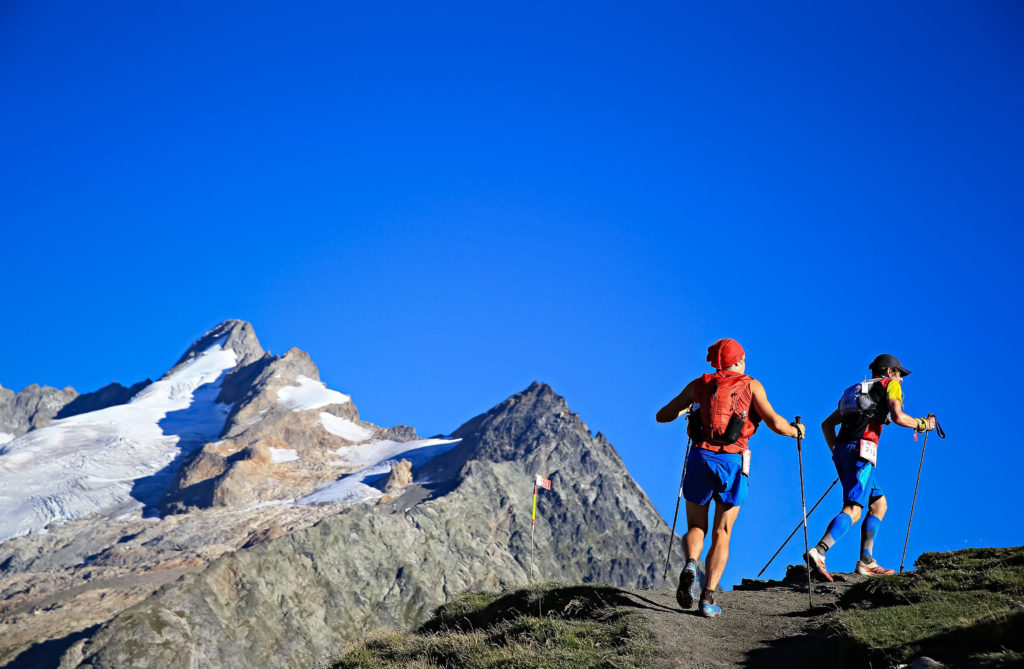
Some fell runners dismiss them as “cheat sticks”. But look around any European mountain race, and chances are the majority of the field will be carrying these foldable fibreglass friends. At last summer’s Ultra-Trail du Mont-Blanc – widely regarded as Europe’s premier mountain event – they were as much a part of the race day kit as a pair of trail shoes.
“Using poles is still pretty new to me,” says world trail running champion and top British fell runner Ricky Lightfoot. “But as time has progressed, and I’m getting older, you begin to consider different options. Towards the end of an ultra, when my legs are getting tired, I’ll often bring out the poles on the ascents to help me move a little faster.”
Does he find them better for going uphill, downhill or on the flat sections? “In my opinion, poles are definitely better for climbing. You may still expend as much energy but using poles spreads the load across your arms and shoulders, saving a percentage of exertion on your legs.”
Ambleside-based sports therapist and sports rehab specialist Adam Smith, himself a seasoned ultrarunner, was so impressed with what the scientific papers said about the benefits of trekking poles that he obtained an instructor’s qualification.
“It’s like using a four-wheel drive,” he says. “However, the best running poles are not the same as trekking poles, which are thicker and tend to support the full weight of a backpack-wearing trekker by landing in front of the legs. I’ve seen a lot of elbow and forearm issues come from runners using these types of poles.”
So what about Nordic poles? “These are a much better option than trekking poles, as they are a lot thinner and lighter, with a passive grip, so the pressure is pushed through the palm. They are designed for lighter people and to be placed behind the person.”
Then there’s the more specialised runners’ poles, such as the Mountain King, a thinner Z-fold pole that comes apart but has a shock cord running through its length. This pulls the pole together again each time it collapses. The compromise of these flexible poles, however, is their inherent weakness at the joins: the more joins they have, the less weight they are able to take. When choosing a trekking pole, therefore, runners should consider how – and how often – they’re likely to use them.
Upper-body workout
Smith believes the UK’s relative resistance to trekking poles is largely down to a lack of knowledge about their benefits. “It is partly a fear of the unknown,” he says. “There is also an element of peer pressure, especially among fell runners, who may not have deep pockets and don’t want to spend money on equipment, so they fail to grasp their benefits.”
And the benefits are many. As well as being good for propulsion uphill, poles help to open up the chest, allowing more oxygen into the lungs. In addition, they are good for improving upper-body strength – an area many runners tend to ignore.
“Your upper-body endurance can improve by as much as 40% by using these poles,” says Smith. “They are also good for your ankle, knee and hip joints as they significantly decrease the ground reaction force.”
However, experts suggest you have to master the technique before you can benefit from using poles.
Lakeland 50 record holder and inov-8 athlete Ben Abdelnoor, who has used poles in the Transalpine multi-day race, agrees: “I found they were more helpful on the ups, when it got steep. On the flat and some of the downs I wasn’t proficient enough to use them to good effect. If you know how to use them, then they’re great, but there’s a knack to them and it takes practice. If you don’t know what you’re doing, they’re a drain!”
3 trekking pole tips
Top ultrarunner Robbie Britton shares his three top tips to trekking pole success
- Practice. Actually, this could be all three tips as it’s vitally important. Practice with them on long runs, up hill and downhill. Poles can be really helpful but only if you know what you’re doing, otherwise they’re just expensive sticks you carry around with you.
- Learn from others. When I first started using poles, I was just swinging my arms as I would when running. Then I saw all the Europeans doing it differently. It wasn’t until I started cross-country skiing this winter that it dawned on me where their technique came from: it was the same double-poling method used in skate skiing.
- Think about storage: where the hell are you going to put these carbon sticks when you’re not using them? Can you eat and drink while you have them out or will it be too much of a faff? I actually sewed elasticated straps into my shorts last year so they were easy to get out and easy to stow away.






